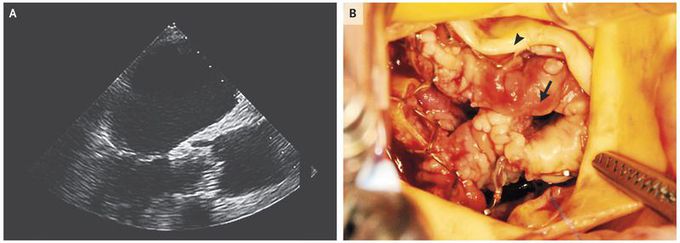


Candida Endocarditis after TAVR
A 76-year-old man with a history of congestive heart failure and an ejection fraction of 45% presented to the emergency department with worsening shortness of breath. He had undergone transcatheter aortic-valve replacement (TAVR) 9 months earlier. His temperature was 39.0°C, and a grade 5 systolic murmur (associated with a palpable thrill) was detected on cardiac examination. A chest radiograph showed changes consistent with pulmonary edema. Laboratory results were notable for a white-cell count of 16,000 cells per cubic millimeter (reference range, 4000 to 10,000) and a C-reactive protein level of 120 mg per liter (reference range, <5). Six consecutive blood cultures were positive for Candida parapsilosis. Treatment with antifungal agents was initiated. Prosthetic-valve endocarditis was confirmed on transesophageal echocardiography , which revealed a large vegetation causing substantial obstruction of the prosthetic valve (transvalvular mean pressure gradient, 52 mm Hg; aortic-valve area, 0.5 cm2). Surgical aortic-valve replacement was performed, and the vegetation (Panel B, arrow) and the native leaflet (Panel B, arrowhead) were visualized. The postoperative course was complicated by wound infection at the surgical site. The patient was discharged but was readmitted 4 weeks later with pneumonia. He died from an aspiration event after a 2-month hospitalization.

